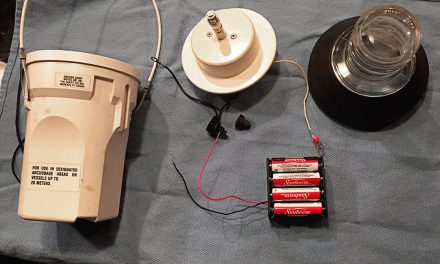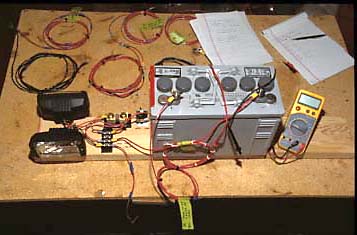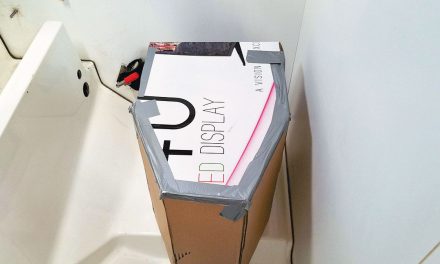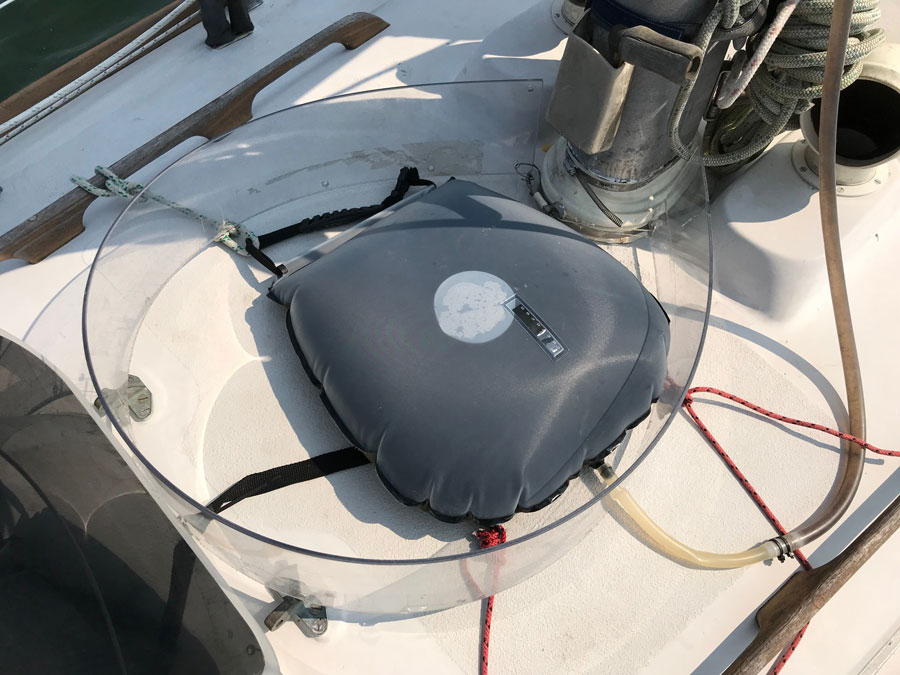If you don’t want to be taken to the cleaners when it comes to cleaning, try these DIY solutions.
Issue 137: March/April 2021

Robin Urquhart, Fiona’s husband, tackles some scrubbing on the foredeck of their Dufour 35, MonArk.
Over the years, I’ve gradually ditched store-bought boat cleaning products and increasingly made my own at home. Most of the time these experiments have resulted in simpler, effective—often more effective than the products they’re replacing—and environmentally friendly cleaning solutions, although it’s true that on the odd occasion, they’ve amounted to a big mess in the galley!
Following are some of my favorite DIY cleaning products that I’ve made over the years. It’s a stretch to call these recipes, as they’re so simple they use only one or two ingredients.
A word of caution: Just because the ingredients are natural, some are strong chemicals, so always wear the appropriate protective clothing and equipment.
Teak Oil
Ingredients: One third cup of boiled linseed oil, one third cup of mineral spirits, and an optional one third cup of varnish. Mix well and store in a sealed container.
Teak oil is a penetrating wood oil that seals and protects teak from the elements. Used by sailors and woodworkers alike, it’s a combination of boiled linseed oil or tung oil, a solvent (mineral spirits, paint thinner, turpentine, naptha), and in some cases a varnish (poly, spar). The oil and varnish harden and provide a protective coating, while the solvent thins the mixture and helps it penetrate the wood grain. You can buy all the ingredients at hardware stores.
I’ve always omitted the varnish when making teak oil because I prefer to apply the oil regularly (twice a month) rather than deal with varnish buildup. We have very little teak on our boat—just grab rails and trim—and applying oil takes fewer than five minutes. However, if you can’t regularly get to your boat, you may want to consider using varnish, as the finish will be more durable and last longer. The downside is that you’ll have to sand off the varnish when it starts to build up and lose its visual uniformity. The non-varnish teak oil does not build up.
When I see the wood beginning to dry out and lighten, I know it’s time to get the teak oil out. I apply the oil on a warm sunny day with a rag or brush, allowing the wood to dry completely before applying a second coat. I generally aim for two to three coats.
The advantage of making your own is that you can adjust the ratios to suit your purposes. Add more varnish for additional protection. Boost the solvent content to make it easier to spread and apply.
A quart of teak oil at the chandlery costs $38. An equivalent quantity of my homemade version costs $7.50. Savings: 80 percent.
Head Cleaning and Descaling Solution
Ingredients: One to two pints of vinegar; a splash of mineral oil, and one gallon of fresh water.

Some of the go-to ingredients that Fiona uses for her home-brewed cleaning products include lemon juice, mineral spirits, and vinegar.
When I first moved onto our boat, I quickly noticed that the marine toilet bowl would develop a scale that was impossible to scrub away. I tried using CLR and other products to no avail. Any head flushed with saltwater will develop this problem. Uric acid and saltwater produce calcium scale in the head and discharge hoses. These deposits accumulate and can make it harder to flush and even block the head completely. Fortunately, it’s an easy problem to fix.
Pour a pint of ordinary white vinegar into the bowl and slowly pump it through such that the liquid sits in the hoses. Pour another pint into the bowl if you have scale in the bowl itself. Let the vinegar sit for a couple of hours. When you return, scrub the bowl with a toilet brush (the scale should come off easily) and flush with one gallon of fresh water. Finally, lubricate the pump by flushing a dash of mineral oil.
Black water system cleaner and descaler at the chandlery can run over $60 a gallon. A gallon of vinegar at my DIY grocery store costs $2-3. Savings: Huge.
Stain Remover and Gelcoat Cleaner
Ingredients: White vinegar, phosphoric acid, and fresh water.
Imagine my dismay when I woke up one morning to discover that our deck was speckled with tiny rust stains. Minute shards of metal from a grinding project had found their way onto the nonskid and were now rusting. No amount of scrubbing and soap would remove them. A fellow boater put me onto phosphoric acid, which not only removed the stains but also brightened the gelcoat.
If you’ve ever read the back of a gelcoat cleaner, you’ll likely see listed ingredients like oxalic acid, phosophoric acid, and citric acid. These chemicals remove stubborn stains from gelcoat surfaces. I’ve used phosphoric acid to remove yellow/brown stains along the waterline and rust stains from our deck and anchor locker. Phosphoric acid is very strong, and you should wear protective gear when using it.
Before applying phosphoric acid, first see if you can remove the stain by using a gentler acid like lemon juice. Apply lemon juice to the surface and let it sit for a couple of minutes. If this doesn’t do the trick, you may want to try phosphoric acid.
Dilute the acid in water according to the instructions on the bottle. Apply with a rag or acid-safe brush and immediately rinse with water. The stain should wash off. If this doesn’t work, you can experiment with less dilute mixes or longer application times. Be aware you can bleach out the surface if you leave the product on for too long or forget to rinse.
If you have rust stains like we did, you also need to remove the metal that is causing the rust to prevent additional staining. In our case this meant carefully scraping the metal shavings out of the nonskid deck with a knife.
At the chandlery, a phosphoric acid cleaner costs $33 per quart. At the hardware store, a similar gallon of phosphoric cleaner costs $12 per quart. Savings: 64 percent.
Good Old Boat Contributing Editor Fiona McGlynn cruised from Canada to Australia on a 35-foot boat with her husband, Robin. She lives above 59 North latitude and runs Wa-terborneMag.com, a site dedicated to millennial sailing culture.
Thank you to Sailrite Enterprises, Inc., for providing free access to back issues of Good Old Boat through intellectual property rights. Sailrite.com





